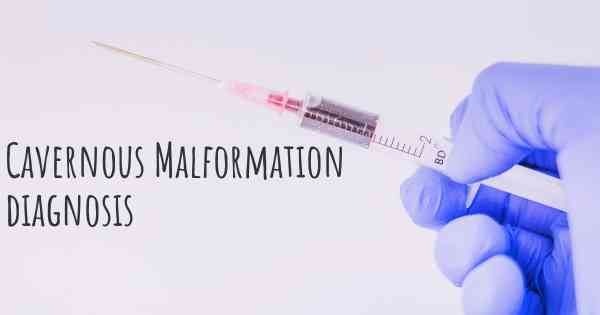How is Cavernous Malformation diagnosed?
See how Cavernous Malformation is diagnosed. Which specialists are essential to meet, what tests are needed and other useful information for the diagnosis of Cavernous Malformation

Cavernous Malformation, also known as Cavernous Angioma or Cerebral Cavernous Malformation (CCM), is a vascular disorder characterized by abnormal clusters of dilated blood vessels in the brain or spinal cord. These clusters, called cavernous malformations, can cause various symptoms and complications, including seizures, headaches, neurological deficits, and even hemorrhages.
Diagnosing Cavernous Malformation
Diagnosing cavernous malformation typically involves a combination of medical history evaluation, physical examination, and imaging tests. The process aims to identify the presence of cavernous malformations, determine their location, and assess the risk of potential complications.
1. Medical History Evaluation: The first step in diagnosing cavernous malformation involves discussing the patient's symptoms, medical history, and any family history of similar conditions. This information helps the healthcare provider understand the patient's specific situation and guide further diagnostic steps.
2. Physical Examination: A thorough physical examination is conducted to assess neurological function and identify any signs or symptoms associated with cavernous malformation. This may include evaluating reflexes, muscle strength, coordination, and sensory perception.
3. Imaging Tests: The primary diagnostic tool for cavernous malformation is imaging tests, which provide detailed images of the brain or spinal cord. The most commonly used imaging techniques include:
- Magnetic Resonance Imaging (MRI): MRI uses powerful magnets and radio waves to create detailed images of the brain or spinal cord. It can accurately detect and locate cavernous malformations, even those that have not caused symptoms.
- Magnetic Resonance Angiography (MRA): MRA is a specialized form of MRI that focuses on the blood vessels. It can help visualize the blood flow within and around the cavernous malformations.
- Computed Tomography (CT) Scan: CT scans use X-rays to create cross-sectional images of the brain or spinal cord. While not as sensitive as MRI, CT scans can be useful in emergency situations or when MRI is not readily available.
- Cerebral Angiography: This invasive procedure involves injecting a contrast dye into the blood vessels to visualize their structure and identify any abnormalities. Cerebral angiography is typically reserved for cases where other imaging tests are inconclusive or when surgical intervention is being considered.
4. Genetic Testing: In some cases, genetic testing may be recommended, especially if there is a family history of cavernous malformation. Genetic testing can help identify specific gene mutations associated with the condition and provide valuable information for both diagnosis and family planning.
Conclusion: Diagnosing cavernous malformation involves a comprehensive approach that combines medical history evaluation, physical examination, and imaging tests. The use of advanced imaging techniques, such as MRI and MRA, is crucial in accurately detecting and locating cavernous malformations. Genetic testing may also be considered, particularly in cases with a suspected genetic component. Early and accurate diagnosis is essential for appropriate management and treatment of cavernous malformation.
Posted Oct 26, 2017 by Teressa 650
Posted Oct 26, 2017 by Lynn 400
Posted Oct 26, 2017 by Michael 500
Posted Oct 27, 2017 by Ljs911 400
Posted Oct 28, 2017 by Beatrice 2000








